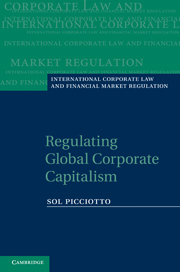Book contents
- Frontmatter
- Contents
- Preface
- Acknowledgements
- Table of cases
- Abbreviations and acronyms
- 1 Transformations of global governance
- 2 Liberal internationalism: strengths and limits
- 3 From interdependence to fragmentation
- 4 Corporations and competition
- 5 Corporate rights and responsibilities
- 6 International taxation
- 7 Regulation of international finance
- 8 The WTO as a node of global governance
- 9 Intellectual property rights
- 10 Law and legitimacy in networked governance
- Bibliography
- Index
7 - Regulation of international finance
Published online by Cambridge University Press: 05 June 2012
- Frontmatter
- Contents
- Preface
- Acknowledgements
- Table of cases
- Abbreviations and acronyms
- 1 Transformations of global governance
- 2 Liberal internationalism: strengths and limits
- 3 From interdependence to fragmentation
- 4 Corporations and competition
- 5 Corporate rights and responsibilities
- 6 International taxation
- 7 Regulation of international finance
- 8 The WTO as a node of global governance
- 9 Intellectual property rights
- 10 Law and legitimacy in networked governance
- Bibliography
- Index
Summary
Finance provides the lubrication for the economy and society. It is a powerful socialization mechanism, linking savings and investment, allocating resources, funding deferred liabilities such as pensions, and managing risks and contingencies, especially through insurance. Bankers and financiers have historically been discreet but powerful, wielding decisive influence behind the scenes in both business and politics, while facilitating myriad petty transactions as well as structuring large-scale deals. Its central paradox is that although a stable and sound system of money, credit and finance is a key public good, banking and finance have generally been treated as a private sphere. This paradox was starkly dramatized by the great financial crisis of 2007 to 2008, which followed a long period of liberalization and privatization, but required extensive state nationalizations and bailouts of financial firms. While these were regarded as short-term measures, the crisis resulted in protracted debate and further extensive regulatory measures, loosely coordinated internationally. However, without a determined move to set finance on new structural foundations, regulation will not prevent future such crises.
Transformations of international finance
From banking to financial capitalism
The modern era of financial capitalism emerged in the last part of the nineteenth century, in conjunction with the rise of corporate capitalism (discussed in Chapter 4). Two significant shifts were involved. First was the extension of the function of finance from providing commercial credit (for commodity circulation in trade) to investment credit (for production).
- Type
- Chapter
- Information
- Regulating Global Corporate Capitalism , pp. 258 - 298Publisher: Cambridge University PressPrint publication year: 2011



